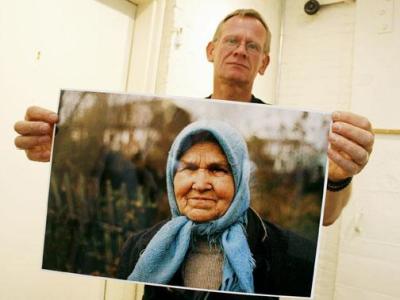REMEMBERING THROUGH ART

Thomas Wernicke of Germany, holds a photograph for his exhibit Berditchev, which will open
at the Catherine Dianich Gallery on Main Street
As the son of a former soldier in Hitler's army, Thomas Wernicke grew up in East Berlin with unanswered questions about his father's past.
His father, who was not a Nazi but merely a young architecture student who was drafted, nonetheless played a small part in one of humanity's greatest crimes and Wernicke struggled to understand how his country and his father could have let such a thing happen.
Wernicke, 53, got a little closer to answering those questions in a barren field in the Ukraine.
On Friday, at the Catherine Dianich Gallery on Main Street, the world wide premiere of Wernicke's installation, "Eye-witness accounts of the 1941 Berditschev killing fields," will open.
Nobody knows exactly how many Jews the Nazis killed that year in the Ukraine town of Berditschev.
In the fall of that year, the German soldiers had their prisoners dig ditches and thousands of the Jewish villagers were shot and buried in massive graves.
Michael Wanscheinbeum was 13 at the time and lost his entire family.
His image and voice are part of the multi-media show which includes sculpture, video, audio and photography.
As Wernicke was unpacking the show at the gallery Tuesday afternoon, he explained how the stories of the Berditschev massacre help us remember an event that should not be forgotten, while calling us to fight the racism that still exists around the world today.
"I am not a historian. We are seeing this all over Europe with a new kind of nationalism," he said, partly through an interpreter. "There has been no learning from what happened in Berditschev and we have to find a way to live with each other."
Wernicke is an art teacher and artist who lives in Berlin.
He first learned about the killing fields of Berditschev a few years ago when he was working in a friend's garden.
An old woman walked up and introduced herself, speaking perfect German and Wernicke asked where she learned to speak his native language so well.
She explained how she was forced to flee her home when the Germans invaded and eventually she told him what happened in Berditschev.
He returned and eventually found four Berditschev natives who remembered the mass killings.
Along with Wanscheinbeum, the artist interviewed Ida Berson, who got out just as the Nazis were invading the village.
He spoke with Bella Reinsdorf, who was sent to visit her grandparents before the killings, only to return to find that 42 members of her family had been killed.
And he documented the story of Isaak Bakmajew, who survived two-and-a-half years with his family hiding in a basement.
Today the killing fields are marked with memorial stones.
A steel windmill, that stood in the middle of one of the fields, is included in the show and a tape of its eerie rattle will play while visitors are in the gallery.
Dianich heard about the show through a mutual friend and decided to bring it to Brattleboro even though she has never staged a multimedia show in her Main Street gallery.
"The first thing I seek to do with a show is engage people and this clearly falls into that," Dianich said as she worked with Wernicke to install the show. "At first it wasn't a show I thought was a good fit for this gallery but the more I learned about it the more I realized I had to hold it in this space. It is a story that has to be told again and again and again."
When Wernicke hung a portion of the show in a gallery window in Berlin earlier this year, a car stopped out in front and someone got out and smashed the glass with his foot.
"I want people to listen to these voices. It has made me look at my life," he said. "If we want peace in the world, all over the world, people need to make it happen."